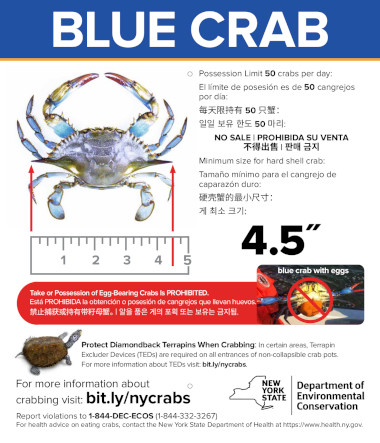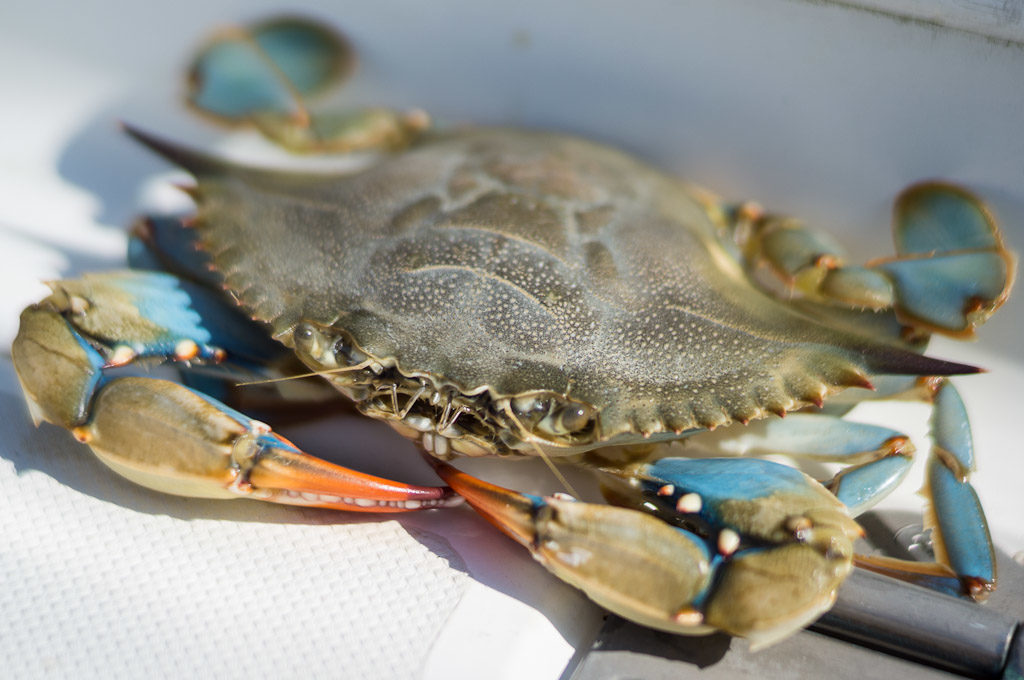Recreational Crabbing in New York

New York State has hundreds of miles of shoreline that provide abundant crabbing opportunities in the Marine and Coastal District, including the Hudson River and it’s tributaries. Crabbing is an inexpensive family fun activity that all ages can participate in.
- No permit or license is required to recreationally crab in New York.
- Visit Saltwater Fishing Regulations for information about size and possession limits before you go crabbing.
- Take or possession of egg-bearing crabs is prohibited.
- Review the NYS Department of Health’s New York State Blue Crab Cooking & Eating Guide (leaves DEC website) before you cook and eat your crabs.
Recreational Crabbing Gear
One method to catch crab is by using a baited handline and dipnet. Drop a bait (oily fish or raw chicken leg) tied to a length of string into the water. If the crabs are there, you will see your line go tight. If you retrieve the line slowly, you can scoop the crab up with your dipnet.
Another method is to set a collapsible trap or non-collapsible crab pot baited with oily fish such as menhaden or mackerel. Crabs will climb into your trap in search of the bait. Simply retrieve the trap and collect your crabs. Please note that there are certain rules you must follow when setting non-collapsible crab pots.
Crab Pot Rules
1. If a pot is marked with a buoy it must be clearly visible and attached to the pot with sinking line. The buoys must be marked with fluorescent or reflective material. The buoy must also be marked with contact information such as a phone number.
2. Do not set pots within 25 feet of designated navigation channels.
3. Non-collapsible crab pots must have:
- Escape panel that’s at least six by four inches in length and height.
- Terrapin Excluder Devices (TEDs) fastened inside each funnel entrance of the crab pot to reduce the size of the funnel opening to no larger than 4-3/4 inch by 1-3/4 inch. These must be used in pots set in rivers, tributaries, creeks and canals on the south shore and bays and harbors on the north shore.
- View the interactive map for more information about where TEDs are required.
Diamondback terrapin (Malaclemys terrapin) are found in the local bays and estuaries of the marine district. This turtle species plays an important role in maintaining the health of saltmarsh ecosystems that many of our other marine species rely on. Unfortunately, terrapins enter crab pots in search of food. Once inside a crab pot, terrapin cannot find the exit; they cannot surface or breathe, and they drown inside. Installation of TEDs on crab pots keep terrapins out and let blue crabs in. Do your part to help diamondback terrapins by installing TEDs on all the entrances to your pots.
A small number of TEDs (provided by The Nature Conservancy (TNC) and Seatuck Environmental Association) will be available to crab pot fishers on a first come/first serve basis at no cost. Please contact us at 631-444-0444 or [email protected] for more information.
For more on this topic, view TNC’s “Save the Terrapins” video (leaves DEC website).
Citizen Science
We are asking for the assistance of recreational crabbers in reporting their crab harvest using the Recreational Blue Crab Survey and reporting any tagged crabs you may encounter to the Blue Crab Tagging Program.
The information you provide will help us better manage the New York blue crab fishery.
Commercial Crabbing

A commercial crab permit is required to harvest blue crab commercially in New York. The commercial crab fishery is a limited entry fishery. For more information about the commercial crab permit, please visit the Marine Permits and Licenses page.
Size limits and gear restrictions exist for the blue crab fishery. For more information about specific blue crab management measures please visit the Commercial Limits for Lobsters, Crabs & Whelk page and be sure to review the crab pot regulations (link leaves DEC’s website) page before setting your crab pots.
Please note: Any person who is the holder of a marine commercial crab permit is required to submit a Vessel Trip Report (VTR) for each commercial fishing trip taken. For more information, please visit the Vessel Trip Reports page.
We are asking for the assistance of commercial crabbers in reporting any tagged crabs you may encounter to the NYSDEC Blue Crab Tagging Program page.
Other Crab
Other species of crab that are commonly harvested for food include the lady (calico) crab, and the rock crab. Green crabs and mole crabs are commonly harvested for use as bait. Be sure to visit our Saltwater Fishing Regulations page before you go crabbing to learn the daily possession limit for these species.
Invasive Species
Invasive species are non-native species that are introduced to our waters. The introduction of these species causes or is likely to cause harm to the ecosystem. These species can spread rapidly and compete with native species of marine life.
Some examples of invasive crab species include the Chinese mitten crab (Eriocheir sinensis), and the dungeness crab (Cancer magister). If you capture an invasive species, do not release it. Instead photograph the crab and note the location and date of capture, then call 631-444-0444 to report it.
Remember, never release any non-native animal or plant into the wild. This includes marine animals bought from a market or pet store. For more information about marine invasive species, visit the Marine Invasive Species webpage.
More about Crabbing in NY:
- NYSDEC Blue Crab Tagging Program – Information on how to report a tagged blue crab and more about NYSDEC’s Blue Crab Tagging Program.
- Recreational Blue Crab Survey – NYSDEC is conducting a survey of people recreationally fishing for blue crabs.

